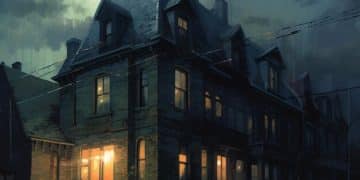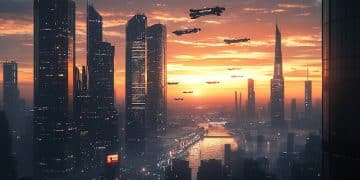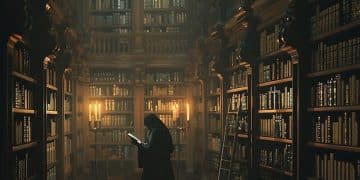Decoding Dark Fantasy: US Tropes & Trends Unveiled
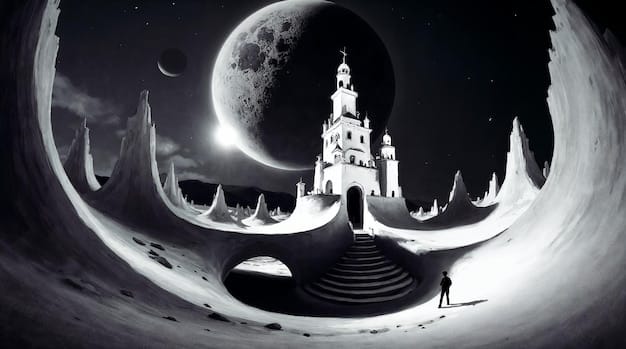
This article delves into the core elements and evolving characteristics of dark fantasy literature and media in the U.S., exploring its distinctive tropes, thematic trends, and the reasons behind its sustained appeal to audiences seeking narratives that challenge conventional heroism and embrace moral ambiguity.
In the vast landscape of genre fiction, few realms captivate and unsettle quite like dark fantasy. A genre that delves into the shadowy corners of myth and magic, it blends the fantastical with a pervasive sense of dread, moral ambiguity, and often, tragic outcomes. This exploration into Decoding Dark Fantasy: Identifying the Key Tropes and Trends Shaping the Genre in the US seeks to unravel its complex tapestry, examining the recurring narrative devices, character archetypes, and thematic undercurrents that define its unique identity within the American literary and media scene. From its historical roots to its contemporary manifestations, understanding dark fantasy requires a journey through its distinct elements that set it apart from its high fantasy counterpart, offering a richer, often more visceral experience for its readers and viewers.
the distinct essence of dark fantasy: more than just grimness
Dark fantasy, as a genre, defies simple categorization. It is often mistakenly conflated with horror or even grimdark fantasy, yet it possesses a nuanced identity that is both pervasive and profound. Its essence lies not merely in its darkness or its grim subject matter, but in its strategic use of these elements to achieve a specific narrative and emotional effect. Unlike traditional high fantasy, which often champions clear-cut heroes and battles between unequivocal good and evil, dark fantasy frequently blurs these lines, immersing readers in worlds where heroism is compromised, morality is relative, and hope is a scarce commodity.
The genre thrives on exploring the human condition under duress, often featuring protagonists burdened by their pasts or forced to make terrible choices. This approach allows for a deeper psychological dive into characters, revealing their flaws and vulnerabilities, making them more relatable despite their fantastical settings. The magic encountered in these narratives is rarely benevolent; it might be insidious, corrupting, or simply a neutral force with devastating consequences when wielded by flawed individuals. This inherent uncertainty regarding the nature of power and morality is a cornerstone of dark fantasy’s appeal.
the subversion of traditional fantasy tropes
One of the most compelling aspects of dark fantasy is its deliberate subversion of familiar fantasy conventions. Where high fantasy often features noble knights, benevolent wizards, and clear quests, dark fantasy introduces jaded anti-heroes, morally ambiguous magic-users, and quests that lead to Pyrrhic victories or even damnation. This inversion of expectations is not done for shock value alone; it serves to ground the fantastical elements in a more realistic and often bleak worldview.
Consider the typical hero’s journey: in dark fantasy, this journey is frequently fraught with personal sacrifice that may not result in ultimate triumph, or the “hero” might become corrupted in the process. The classic dichotomy of good versus evil is replaced by shades of grey, where characters may possess virtuous intentions but are forced into cruel actions, or where malevolent forces reveal surprising depths of tragedy. This complexity resonates with a mature audience looking for stories that reflect the ambiguities of the real world, rather than simple escapism.
- Broken heroes: Protagonists are often flawed, cynical, or haunted by past failures.
- Ambiguous morality: Good and evil are rarely clear-cut; characters operate in moral grey areas.
- Grim settings: Worlds are often decaying, post-apocalyptic, or perpetually shadowed.
- Destructive magic: Magical systems often come with high costs or corrupting influences.
Furthermore, the environmental storytelling in dark fantasy is crucial. Worlds are not merely backdrops but active participants in the narrative, reflecting the internal turmoil of characters or the pervasive decay of society. Landscapes might be desolate, ruins might whisper tales of forgotten tragedies, and nature itself might pose a threat, rather than serving as a comforting presence. This sense of pervasive melancholy and decay contributes significantly to the genre’s unique atmosphere, drawing readers into a world where beauty and hope are fleeting, and darkness often prevails.
character archetypes: the anti-hero’s dominion
In the realm of dark fantasy, the traditional hero is often replaced by a more complex and morally ambiguous figure: the anti-hero. These characters are central to the genre’s appeal, embodying its nuanced approach to morality and human nature. Unlike the valiant champions of high fantasy, anti-heroes are driven by personal gain, revenge, self-preservation, or a twisted sense of justice. Their actions, though sometimes leading to positive outcomes, are rarely motivated by altruism, and their methods can be ruthless, even cruel.
This focus on flawed protagonists allows authors to explore deeper psychological terrain, examining what happens when individuals are pushed to their limits in desperate circumstances. These characters are often burdened by their past, carrying scars—both physical and emotional—that inform their decisions and shape their cynical outlook. Their struggles are less about achieving a grand, world-saving victory and more about personal survival, redemption (or the lack thereof), or navigating a world that offers no easy answers.
the conflicted protagonists and their allies
The anti-hero is rarely a solitary figure; they are often surrounded by an equally diverse cast of conflicted allies and formidable adversaries. Allies might range from reluctant companions to dangerous partners, each with their own murky motivations. These relationships are often fraught with tension, distrust, and shifting loyalties, adding layers of intrigue to the narrative. The dynamics between these characters reinforce the genre’s theme of moral relativism, where everyone, regardless of their allegiances, must contend with their own inner demons and external pressures.
The adversaries in dark fantasy are seldom cartoonishly evil. While some may represent pure malevolence, many are complex figures with their own tragic backstories or understandable, albeit misguided, motivations. This dimensionality of antagonists deepens the moral quandary of the narrative, making battles less about good vs. evil and more about conflicting ideologies, personal grudges, or the desperate struggle for survival in a harsh world. This sophisticated approach to characterization is a hallmark of the genre, allowing for rich, multifaceted storytelling that avoids simplistic resolutions.
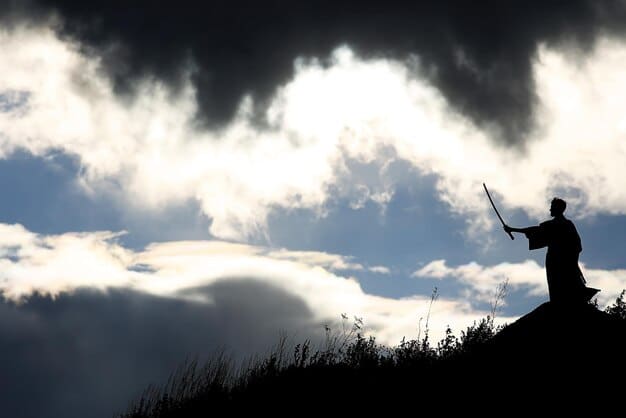
thematic explorations: despair, moral ambiguity, and redemption
Dark fantasy delves into a compelling array of themes that resonate deeply with audiences seeking narratives beyond simplistic good-versus-evil paradigms. Central to its thematic core are elements of despair, pervasive moral ambiguity, and the often elusive quest for redemption. These themes are not merely decorative but are intrinsic to the genre’s narrative structure, shaping character arcs and world-building with a distinctive gravitas. In dark fantasy, the answers are rarely clear-cut, and the journey is often more significant, and painful, than the destination.
Despair often manifests as a foundational element, an underlying current that permeates the world and its inhabitants. Societies might be crumbling, diseases might run rampant, or ancient evils might be stirring, casting a long shadow over any glimmer of hope. This pervasive sense of hopelessness serves to amplify the stakes for characters, making their small victories feel monumental and their failures utterly devastating. The narrative often explores how individuals cope, or fail to cope, when faced with overwhelming odds and an indifferent cosmos, questioning the very definition of resilience.
moral greys and the elusive promise of redemption
Perhaps the most defining thematic element of dark fantasy is its unwavering commitment to moral ambiguity. Characters are seldom purely good or purely evil; instead, they operate within a spectrum of motivations and actions, forced to make impossible choices with profound consequences. This moral greyness extends to the narrative itself, where heroic deeds might have unforeseen negative repercussions, and acts of villainy might be born from understandable pain or desperation. This complexity encourages readers to grapple with difficult ethical questions, fostering a more thoughtful and engaged reading experience.
- Consequences matter: Actions, whether good or bad, have lasting and often harsh repercussions.
- Sacrifice is common: Characters frequently face personal loss and make difficult sacrifices.
- Hope is a struggle: Glimmers of hope are hard-won and often short-lived.
Redemption, when it appears, is rarely a clean slate. It is often a painful, protracted process, earned through immense suffering, and sometimes incomplete. A character might achieve a semblance of redemption for past wrongs, but the scars remain, and the world remembers their transgressions. This realistic portrayal of atonement, where forgiveness is not easily given and consequences linger, distinguishes dark fantasy from genres that offer simpler paths to absolution. The genre suggests that true redemption lies not in erasing past sins, but in learning to live with them and making better choices moving forward, even if those choices are still fraught with difficulty.
setting the stage: atmospheric world-building in dark fantasy
The worlds of dark fantasy are not mere backdrops; they are deeply atmospheric and often oppressive entities that actively influence the narrative and its inhabitants. Unlike the vibrant, often idyllic realms of high fantasy, dark fantasy settings are typically bleak, decaying, or inherently hostile, mirroring the moral and psychological turmoil of their characters. This meticulous world-building is crucial for establishing the genre’s signature mood, immersing readers in environments that feel both fantastical and ominously real.
Common elements include ruined civilizations, desolate landscapes, and societies teetering on the brink of collapse. There’s often a pervasive sense of entropy, where once-grand empires lie in ruin, and ancient magics are twisted or misunderstood. This decay isn’t just aesthetic; it serves as a constant reminder of the fragility of power, the fleeting nature of life, and the enduring presence of dark forces that can corrupt or destroy. The very air of these worlds often feels heavy with forgotten sorrow and impending doom, creating an inescapable feeling of dread.
the decaying aesthetics and oppressive environments
The visual and sensory details of dark fantasy settings are crafted to evoke discomfort and despair. Gothic architecture, perpetually overcast skies, and landscapes scarred by war or magical cataclysms are common. Forests are not enchanting but ancient and treacherous; cities are not bustling hubs of commerce but dens of corruption and misery. The elements themselves often conspire against the characters, with relentless rain, biting cold, or suffocating heat adding to the pervasive sense of adversity.
The societies within these worlds often reflect the grim environment. Oppressive regimes, widespread poverty, and constant threats from supernatural entities or warring factions are typical. Survival is often a daily struggle, and ethical compromises are necessary. This creates a fertile ground for exploring themes of resilience, desperation, and the lengths to which individuals will go to protect themselves and their loved ones in a world that offers little comfort or security. The oppressive atmosphere becomes a character in itself, shaping the decisions and fates of those who inhabit it.
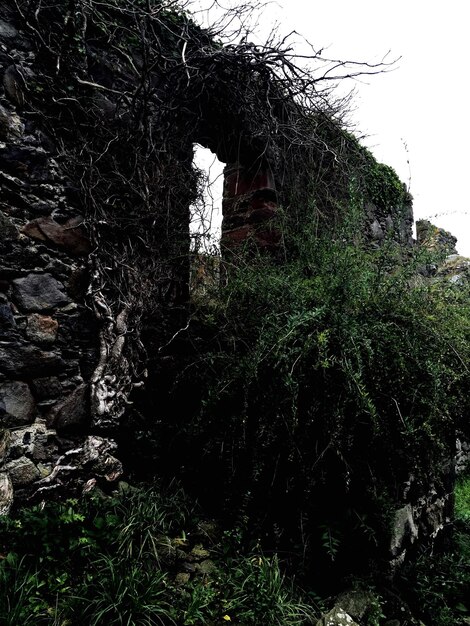
the US influence: distinct trends and cultural resonance
While dark fantasy as a genre has global roots, its manifestation and popular trends within the United States have developed specific characteristics that resonate with American audiences. The US literary and media landscape often reflects a penchant for gritty realism, anti-establishment themes, and a deep exploration of individual struggle against overwhelming odds. This is evident in the types of dark fantasy narratives that gain traction, often blending traditional fantastical elements with a distinctly American sensibility.
One notable trend is the embrace of diverse mythologies and folklore beyond the conventional European canon. While European-inspired settings remain popular, US authors increasingly incorporate elements from Native American legends, African diasporic spiritual traditions, and even urban myths. This offers fresh perspectives and expands the thematic palette of dark fantasy, allowing for richer, more culturally specific explorations of darkness and despair. The genre becomes a vehicle for examining historical injustices, societal anxieties, and the often-unseen struggles within diverse American communities.
urban decay and southern gothic elements
Another significant trend in US dark fantasy is the integration of urban decay and Southern Gothic elements. Instead of medieval castles or desolate plains, stories might unfold in crumbling cityscapes, forgotten industrial towns, or the muggy, haunted landscapes of the American South. This allows for a contemporary relevance, grounding the fantastical within familiar, yet often unsettling, real-world settings. The decay of the urban environment or the oppressive atmosphere of the rural South naturally lends itself to the genre’s themes of corruption, moral rot, and lingering historical shadows.
Authors often utilize these settings to explore social commentary, tackling issues such as environmental degradation, economic disparity, and systemic oppression. The monsters in these stories might not just be mythical beasts but manifestations of human cruelty or societal failings. This blend of the fantastical with sharp social critique creates a powerful narrative that resonates with readers who appreciate stories that both entertain and provoke thought. The genre becomes a mirror reflecting the darker aspects of the American experience, offering a cathartic encounter with its anxieties.
- Diverse mythologies: Incorporating folklore from various cultural backgrounds beyond traditional European.
- Urban settings: Shifting from classic fantasy landscapes to modern, often decaying, city environments.
- Southern Gothic influence: Blending supernatural elements with the brooding atmosphere and historical weight of the American South.
- Social commentary: Using fantastical narratives to critique real-world societal issues and injustices.
Furthermore, the influence of American cinema and television, particularly within the horror and crime genres, has subtly shaped the pacing and storytelling conventions of dark fantasy. There’s often a lean towards suspense, psychological tension, and a greater emphasis on gritty, realistic violence rather than stylized combat. This cinematic approach means narratives often unfold with a heightened sense of urgency and directness, appealing to audiences accustomed to fast-paced, visceral storytelling. The genre in the US is thus a dynamic confluence of literary tradition, cultural specificity, and media evolution.
the enduring appeal of shadows: why dark fantasy captivates
The enduring appeal of dark fantasy lies in its ability to grapple with complex human experiences that high fantasy often sidesteps. It offers an unflinching look at the darker aspects of existence: fear, loss, moral compromise, and the pervasive nature of evil—both external and internal. This willingness to explore difficult truths resonates with a significant portion of the audience who find escapism not in unwavering heroism, but in the gritty realism applied to fantastical concepts. It’s a genre that mirrors the ambiguities and struggles of the real world, albeit through a fantastical lens.
One of the primary reasons for its sustained popularity is its capacity for psychological depth. Dark fantasy characters are relatable because their struggles speak to universal human anxieties and flaws. They make mistakes, suffer consequences, and are often burdened by their choices, reflecting the imperfection of the human condition. This sense of authenticity, even within fantastical settings, creates a powerful emotional connection between the reader and the narrative, making the characters’ triumphs or failures feel deeply personal. It’s a genre that doesn’t shy away from pain, and in doing so, offers a unique form of catharsis.
a mirror to our anxieties and the yearning for light amidst darkness
Dark fantasy also serves as a potent vehicle for exploring societal anxieties and the human response to chaos. In an increasingly complex world, narratives that acknowledge and dissect shades of grey rather than presenting clear-cut solutions can feel more genuine and relevant. The genre allows authors to tackle existential questions, the nature of power, and the limits of endurance, using fantastical elements as metaphors for real-world dilemmas. This intellectual engagement elevates dark fantasy beyond mere entertainment, transforming it into a space for profound reflection.
Despite its inherent darkness, the genre is not entirely devoid of hope. Rather, the hope found within dark fantasy is often hard-won, fragile, and more precious precisely because of the pervasive shadows against which it flickers. It’s the hope that arises from resilience in the face of despair, from small acts of kindness in a cruel world, or from the determination to carry on even when victory seems impossible. This delicate balance between overwhelming dread and the persistent, if faint, possibility of light is what makes dark fantasy so compelling. It acknowledges the darkness, but in doing so, amplifies the significance of any fight for illumination, making it a powerful and profoundly moving experience for readers worldwide.
| Key Aspect | Brief Description |
|---|---|
| 🎭 Anti-Heroes | Flawed protagonists with complex motivations, often challenging traditional heroic ideals. |
| ⚖️ Moral Ambiguity | Blurred lines between good and evil; characters operate in ethical grey areas. |
| 🏚️ Grim Settings | Worlds characterized by decay, oppression, or inherent hostility, reflecting despair. |
| 🇺🇸 US Trends | Integration of diverse mythologies, urban decay, and Southern Gothic elements. |
frequently asked questions about dark fantasy
Dark fantasy inherently explores bleak themes and flawed characters, but it doesn’t necessarily exclude hope or redemption. Grimdark, however, emphasizes a more pervasive sense of cynicism and nihilism, often with moral degradation and little to no hope for positive outcomes. While overlap exists, dark fantasy retains a broader thematic scope.
Yes, while not always strictly defined, common sub-genres include Urban Dark Fantasy (fantastical elements in modern city settings), Historical Dark Fantasy (gritty magic in historical contexts), and often blends with sub-genres of horror or gothic fiction. The lines are fluid, allowing for diverse narratives.
Moral ambiguity allows for a deeper and more realistic exploration of human nature. By blurring the lines between good and evil, dark fantasy challenges readers to confront difficult ethical questions, making characters more complex and relatable. It reflects the real world’s lack of clear-cut solutions.
Dark fantasy settings are typically bleak, decaying, or inherently hostile, mirroring the internal turmoil of characters. Unlike the often idyllic or vibrant realms of high fantasy, these worlds emphasize entropy, ruin, and a pervasive sense of oppression, directly influencing narrative and mood.
Key examples include “A Song of Ice and Fire” by George R.R. Martin, “The Broken Earth” series by N.K. Jemisin, and works by authors like Joe Abercrombie or Mark Lawrence. These series showcase the genre’s key tropes, focusing on flawed characters and morally complex worlds.
the enduring power of the shadows
In conclusion, dark fantasy stands as a formidable and ever-evolving genre within the American literary and media landscape. It is defined not merely by its grim aesthetic, but by its profound commitment to exploring the complex nuances of morality, the fragility of hope, and the resilience of the human spirit in the face of overwhelming despair. By subverting traditional tropes, championing the anti-hero, and creating worlds steeped in atmospheric decay, dark fantasy offers a compelling reflection of our own anxieties and the enduring struggle between light and shadow. Its continued popularity speaks to a deep human need for stories that reflect life’s complexities and offer a hard-won, yet deeply resonant, sense of truth.


